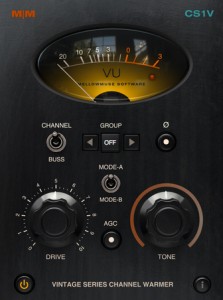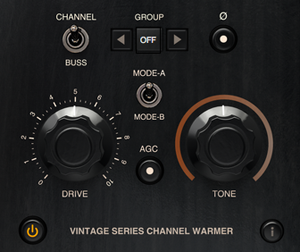Review: Mellowmuse CS1V Channel Warmer
PARK SLOPE, BROOKLYN: While many audio professionals (myself included) have a love/hate relationship with the digital audio world, most of us would agree that we would be hard-pressed to make a living without our DAWs on a day-to-day basis.
There are, however, a few things that we all wish we could take with us from the days when razorblades, swabs, analog tape and consoles were found in every studio. What I’m talking about is warmth and saturation.
For all its invaluable qualities, the DAW platform is essentially a blank canvas, and a sterile one at that. Analog consoles by nature inject a small amount of sonically pleasing harmonic distortion into the sound on each channel. Their tape machine counterparts rolled off a slight bit of top end and bumped a slight bit of low end. Together they helped enrich the tracks with a warm and pleasing sound.
Following in the footsteps of the brilliant SATV Saturation plug-in (SonicScoop review), Mellowmuse has released their CS1V Channel Warmer, which stands to help bring back the warmth and character missing in the box.
TECH SPECS: The CS1V is a native only plug-in for use on MAC and PC and retails for an astonishingly low $59! Formats available are VST, AU and RTAS at 32 and 64 bit. For those curious about the CS1V, Mellowmuse.com is now offering 7-day fully functioning trials.
WHAT IT DOES: CS1V is a warming preamp style plug-in with a dash of harmonic distortion. The goal of CS1V is to gently take the edge off individual tracks in your mix while adding depth and coloration reminiscent of an analog mixer/console.
THE INTERFACE: Mellowmuse plug-ins, across the line boast, an impressive visual display and CS1V is no different. Working our way down the face…there is a VU meter, switches for CHANNEL or BUSS, a GROUP selector, phase reverse, modes A and B, AGC (automated gain control) and finally the main knobs which control DRIVE and TONE.
The main focus of CS1V is held in these DRIVE and TONE knobs. Working counter clockwise from hard right to left, the TONE knob will subtly shave top end off the track and slightly boost low end which together helps increase overall “warmth”. DRIVE simply adds more grit and harmonic distortion to the signal chain.
Engaging the AGC switch to ON will allow you to add as much DRIVE as you please without disturbing the overall output gain stage. This is an excellent feature and by far the most precise I’ve heard of any of the plug-ins available that utilize this feature.
As CS1V was recently overhauled and updated with CS1V 1.3, MODE A and MODE B essentially represent the old and new algorithms. According to the website, MODE A is darker in character overall while MODE B has a flatter frequency response.
The CHANNEL switch is where most of your action will take place. Selecting BUSS will add very low levels of crosstalk (consoles generally ran -80 to -50dB depending on frequency). The BUSS feature is intended to be used across groups of tracks together with BUSS enabled on each instance.
Finally, CS1V (as well as SATV) now have a selectable group feature. Mellowmuse is the only plug-in manufacturer that I know of utilizing this awesome and powerful feature. Group mode allows the settings within all instances of the CS1V plug-in to be sync’d together and controlled by any one instance of the plug-in. The group selector switch enhances this by allowing the user eight separate groups within CS1V that can be spread across instruments such as drums, guitars, vocals, etc. to all be controlled together. Brilliant!
IN USE: All of my tests of CS1V were within Pro Tools 9. I’ve been fortunate to have CS1V in my arsenal for a couple of months now and waited till and the new version 1.2 was made available to complete my review. In the meantime, CS1V has been a part of several projects since I picked it up and I can say that it is now one of the first plug-ins I reach for to help shape my tracks before I hit them with EQ’s or compression.
Let’s start with vocals. I recently tracked a Christmas single for an upcoming release by Philadelphia-based Wing Court Records artist Ali Hoffman at Gödelstring Recording Studio in Park Slope, Brooklyn. Ali and her band have an incredibly warm, soulful sound that really lends itself to the tape era so CS1V was a natural choice.
The great thing about CS1V is that once you’re familiar with the available tools, it’s really an extremely quick “set it and forget it” type of unit. I selected Mode A (the darker mode) after a bit of switching back and forth between A and B, and then set the TONE knob to about 9 o’clock. This is about 2/3rds of the way to 100% in terms of warmth/darkness. The drive knob was set to about 4.5 with AGC on giving the vocal a very slight amount of harmonic drive while retaining my exact output gain.
CS1V essentially gets my vocal about 75% of where I want it to be tonally out of the gate without any additional EQ. The vocal is present and articulate but not overly shrill or biting. The more I increase the Tone knob to the left, the darker and less shrill the sound becomes. It only takes a few seconds of critical listening and A/Bing to dial in the perfect sound. For a more hard-edged rock type sound, CS1V sounds brilliant with the TONE knob cranked hard left and the DRIVE knob cranked up hard right mimicking that Black Keys-style sound.
Other instruments that were treated with CS1V in my session included acoustic guitar, B3/Leslie and drum overheads. For the acoustic, I chose MODE B (flatter frequency response), which I find can be extremely subtle even at high levels on the Tone knob.
Within MODE B I elected to turn the AGC switch off which enabled me to simultaneously add a very slight amount of dirt to the acoustic sound and also bump the overall level of the track slightly as the acoustic was tracked a few dB too low. The acoustic now has a mellower (no pun intended), thicker sound due to the slight low-end bump.
The B3 was recorded with three mics on a Leslie cabinet, two Coles 4038’s up top and a Neumann U87 on the low horn. Besides being incredibly loud, B3 is often one of the sharpest and most difficult instruments to control in a mix. CS1V does a remarkable job at softening the B3 sound while enhancing all the low register characteristics of the organ. Mode B, with a healthy amount of grit, helps the organ sit perfectly inside my mix.
Group mode was also especially helpful here for controlling all three mics on the Leslie cabinet from just one instance of CS1V, which also allowed me to easily bypass the three plug-ins together for quick A/B. Lastly, I used CS1V on the drum kit overheads to take off just a hint of the top end shrill and gently increase the low end and thickness of the overall sound of the kit.
TO BE CRITICAL: It would be helpful if some basic information about the parameters of certain things, such as MODE-A and MODE-B, was included within the info menu – selectable by the “i” button in the lower right corner. As of this writing, the info button only displays the user’s registration info.
IN CONCLUSION: CS1V has become one of a few go-to plug-ins in my arsenal for any style of music I mix. It helps soften the sharp edges created in the DAW world of limitless frequency bandwidth while simultaneously adding character and depth to tracks.
CS1V is all the great features we miss from tape machines without adding the harsh or artifact-like qualities present in other tape saturation plug-ins. It’s incredibly easy to use and light on CPU usage, which is always a plus. One side-note: besides having a “Class-A sound,” Mellowmuse has amazing customer service. The company’s founder and chief programmer Gary Newby is dedicated to refining and updating his plug-ins to suit the needs and suggestions of his customer base. And all this at a price point of $59!
Click for more information on CS1V and to download a trial version.
Zach McNees is a Brooklyn-based producer/engineer/mixer and live recordist who’s worked with Bjork, Rob Thomas, Julia Nunes, The Gregory Brothers, Pixies, Liars and Alice Cooper. Get in touch with Zach via http://www.zachmcnees.com.
Please note: When you buy products through links on this page, we may earn an affiliate commission.









TryAx
October 14, 2011 at 7:21 pm (14 years ago)slate vcc has had group feature from the beginning
Zach McNees
October 16, 2011 at 3:28 am (14 years ago)Actually you are correct! And nothing against the VCC, It’s definitely pretty cool.